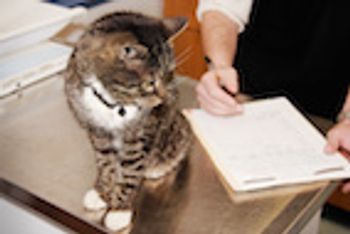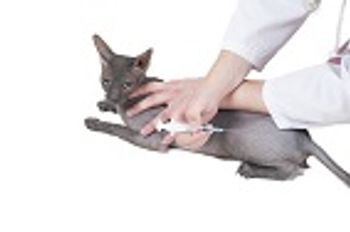
In a recent study, robenacoxib injected subcutaneously at a dosage of 2.0 mg/kg/day for 3 days controlled pain associated with soft tissue surgery in dogs.
Dr. Walden received her doctorate in veterinary medicine from North Carolina State University. She is a practicing veterinarian and a certified editor in the life sciences (ELS). She owns Walden Medical Writing, LLC, and writes and edits materials for healthcare professionals and the general public.

In a recent study, robenacoxib injected subcutaneously at a dosage of 2.0 mg/kg/day for 3 days controlled pain associated with soft tissue surgery in dogs.

Which is better for histologic diagnosis of bone lesions: fine-needle aspiration or biopsy? Each has pros and cons.

What your clients want to know: What type of cancer does my pet have? How extensive is it? How can it be treated? A veterinary cancer expert outlines the basics.

In a recent study, researchers investigated the use of a transdermal lidocaine patch for added pain control in dogs receiving morphine and carprofen after ovariohysterectomy.

A recent study has found that hundreds of thousands of cats in the United States are likely infected with heartworms—and that may be a low estimate.

Surgical decompression is a common treatment measure in dogs with neurologic deficits caused by intervertebral disk extrusion. But which is better—hemilaminectomy or mini-hemilaminectomy?

This week at CVC Virginia Beach, Dr. Susan Ettinger outlined the prevalence, characteristics, diagnosis, and treatment of osteosarcoma in dogs.

DNA sequencing has allowed researchers to create a genetic map of dog breeds. The analysis, which revealed some surprising findings, will allow researchers to identify gene variants responsible for breed development, behavior, and disease.

Is there an association between urolithiasis and chronic kidney disease in cats? Canadian researchers say yes.

Following an analysis of more than 87,000 microscopic agglutination test results, researchers have created a predictive risk map for canine leptospirosis.

European researchers examined the social behaviors of neutered versus intact dogs. Here’s what they found.

The demographics of canine hip dysplasia and its human counterpart—developmental dysplasia of the hip—show some striking similarities.

In a comparison of video versus owner observation in assessing urination behaviors in cats, researchers concluded that a combination of the two methods may be best.

A survey of pet owners who feed their pets raw food products reveals, among other things, a distinct lack of communication about nutrition in the veterinary office.

In a recent One Health lecture, Dr. Laura Kahn talked about antibiotic use in food animals, the challenges of ensuring food security, and possible sources of antibiotic resistance in people.

High worm fecundity and the potential for severe pathology in humans and other hosts make raccoon roundworm a double threat.

A group of researchers recently investigated the molecular barriers that protect human cells against infection with feline leukemia virus.

Owner education, early screening for orthopedic disease, and proper management—including weight loss and exercise—are key to improving comfort and outcome in animals with osteoarthritis.

At the 2017 Western Veterinary Conference in Las Vegas, Nevada, Edward Breitschwerdt, DVM, DACVIM, and Christopher Woods, MD, discussed Bartonella infection from both human and animal perspectives, covering epidemiology, disease manifestations, potential risk to veterinary personnel, and the role of veterinarians in education and prevention.

Polyprenyl immunostimulant may improve survival time and quality of life in cats with noneffusive feline infectious peritonitis.

According to a study, waiting to spay large-breed female dogs until later in their first year of life may decrease their risk of developing urethral sphincter mechanism incompetence.

Finnish researchers have identified the genetic cause of ARDS in Dalmatians, offering new pathophysiologic insight and enabling the development of a genetic test for this multifactorial syndrome.

According to a review recently published in BMC Veterinary Research, the prevalence of CAFRs in dogs and cats varies with the presenting signs and type of diagnosis.

A recent study confirms that cats prefer clean litter to dirty litter, with no difference between litter soiled by themselves or by another cat.

At WVC 2017, Dr. Sarah Moore offered practical tips for testing postural reactions and spinal reflexes in dogs and cats.

At WVC 2017, Dr. Sarah Moore talked about the cranial nerves, including functional assessment and manifestations of dysfunction.

A new drug to treat hypertrophic cardiomyopathy (HCM) in cats has shown promising results in a proof-of-concept study. Because HCM is similar in cats and humans, the drug could also eventually be used in people.

In an article recently published in PLOS Pathogens, researchers discuss disease pathogenesis, treatment challenges, and the potential for feline vaccine development.

In a large study of cats in the United Kingdom, median systolic blood pressure measured by Doppler sphygmomanometry was 120.6 mm Hg, lower than the commonly reported mean of 125 mm Hg by direct intraarterial measurement.

For the first time, researchers have grown human stem cells in early-stage pig embryos. Although it’s sure to spark controversy, this research brings hope for addressing the dire organ shortage.